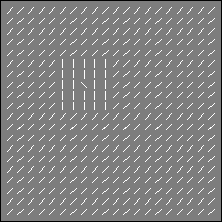
Purpose. We examined the influence of a background array of texture elements on the detectability of a target element (separated from the background by an intermediate region) using textures like those of Caputo (1996, Vis. Res. 36).
Methods. Each stimulus was a square field (5x5 deg, 20x20 texture elements) of short (0.18 deg) line segments (100% white-on-gray Weber contrast), consisting of background, patch, and target regions. In the figure shown here the background consists of 45° lines, the patch consists of 0° lines, and the target is a -45° line. Various aspects of the stimulus were manipulated across experiments. The task was a two temporal interval forced-choice procedure (with feedback). In the target interval a texture like that shown in the figure was presented. In the blank interval a texture with no target element was shown (i.e., the target element was replaced with a 0° patch element).
Results. Detection was better when the background elements were orthogonal to the target element than when they were parallel to it, as if there were orientation-tuned interactions over large distances. We found that this effect held when (1) the sign of the contrast of the target element was changed, (2) orientation varied smoothly from the background to the patch, (3) the patch region elements were circles or were removed entirely, (4) the size of the target region was increased, and (5) the size of the patch region was drastically increased. We have measured the orientation bandwidth of the long range interactions to be at least 20°.
Conclusions. There are long range interactions between oriented texture elements, and these interactions might be accounted for by a model of texture segregation which allows for interactions among low-level filters across space and orientation.

None. Supported by NIH grant EY08266.